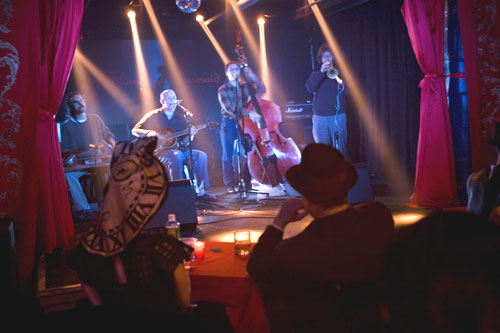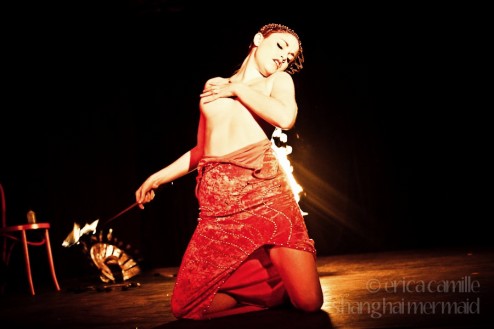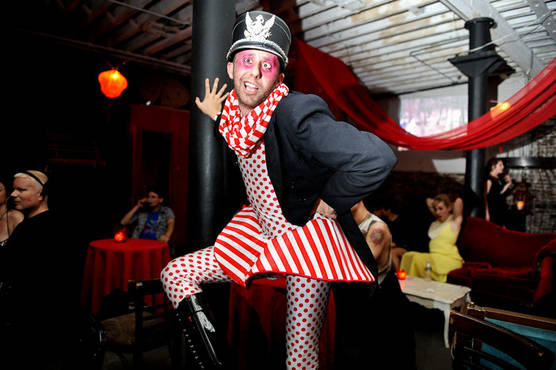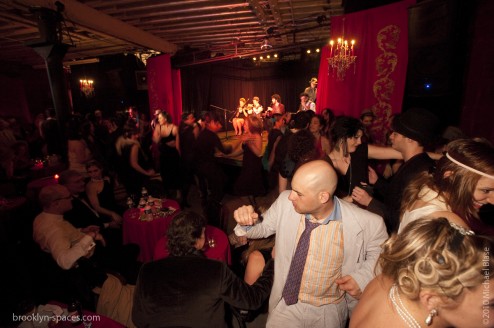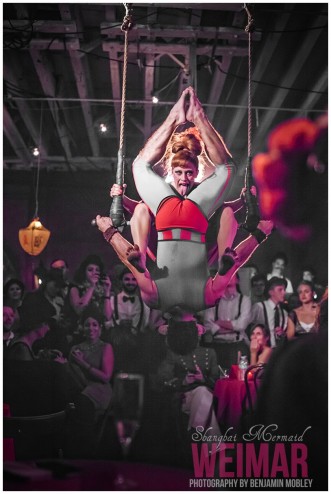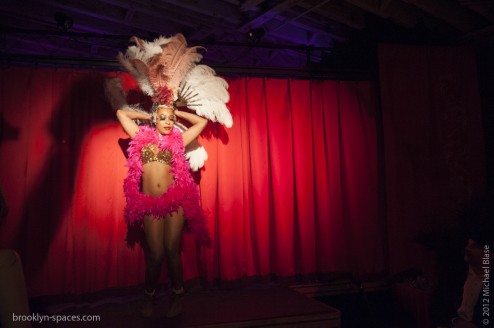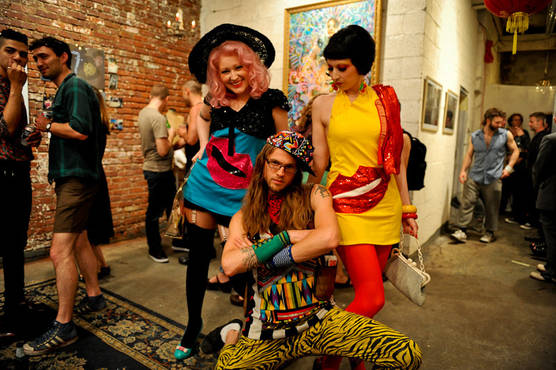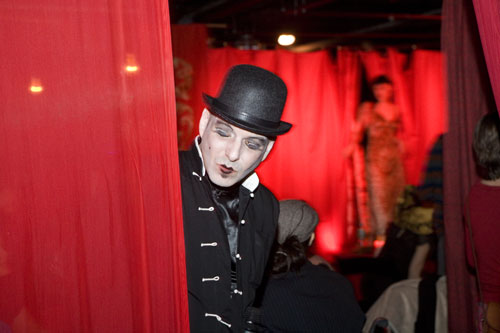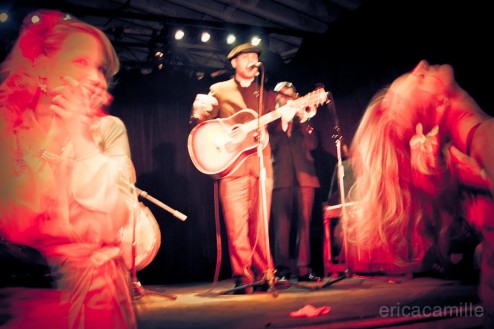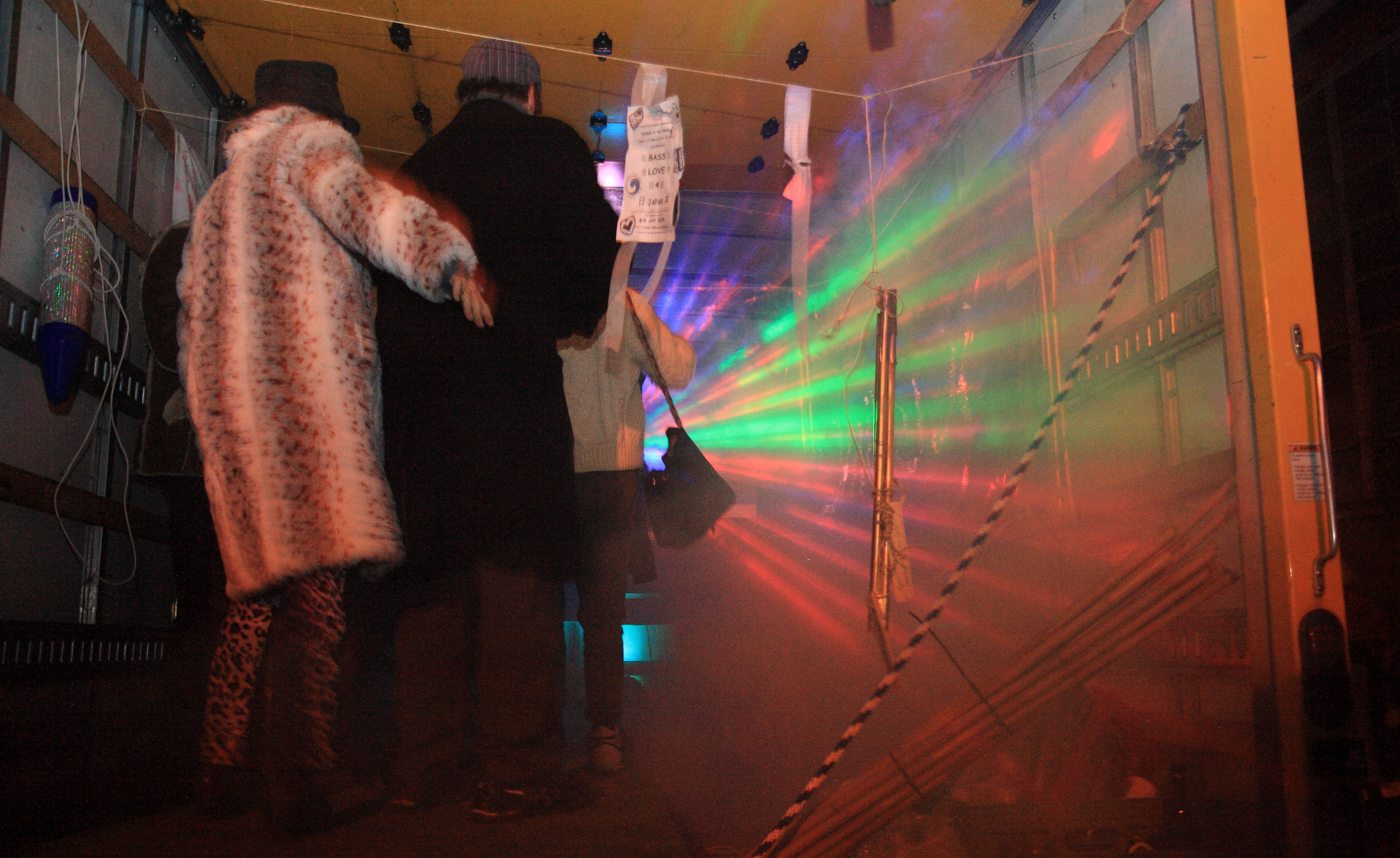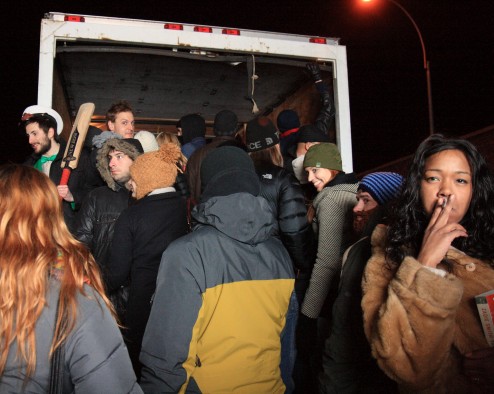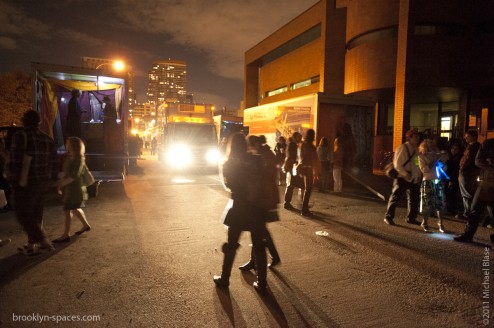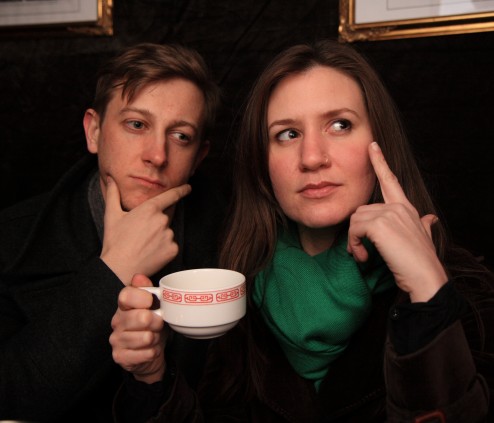red lotus room
space type: parties | neighborhood: crown heights | active since: 2009 | link: blog, facebook
The Red Lotus Room is breathtaking. The first time I went was for BANZAI!!!!!, a surreally crazy art and performance party, full of elaborate costumed revelers, an eclectic selection of multimedia art, and performances from drag acts to DJ sets. The second (and third, and fourth, and fifth) time I went back was for the famous Shanghai Mermaid party, an underground, more-or-less-monthly, themed event (usually Paris, Shanghai, Berlin, or New Orleans in the twenties or thirties), where everyone has to dress accordingly. It was a beautifully bizarre experience, riding the subway out to Crown Heights in period attire, wandering down darkened streets in heels, then stepping through the door into a sprawling, whirling, huge space, walls draped with red velvet, tables laden with candles, everyone in hats and suspenders and fans, sequins and rhinestones and fringes, with cigarette girls hawking candy and treats, exotic cocktails and food, and hours and hours of amazing performers: aerialists, fire dancers, musicians, burlesque, and more. The parties start at ten and go until dawn, if not later. It’s an absolutely phenomenal way to spend a Saturday night.
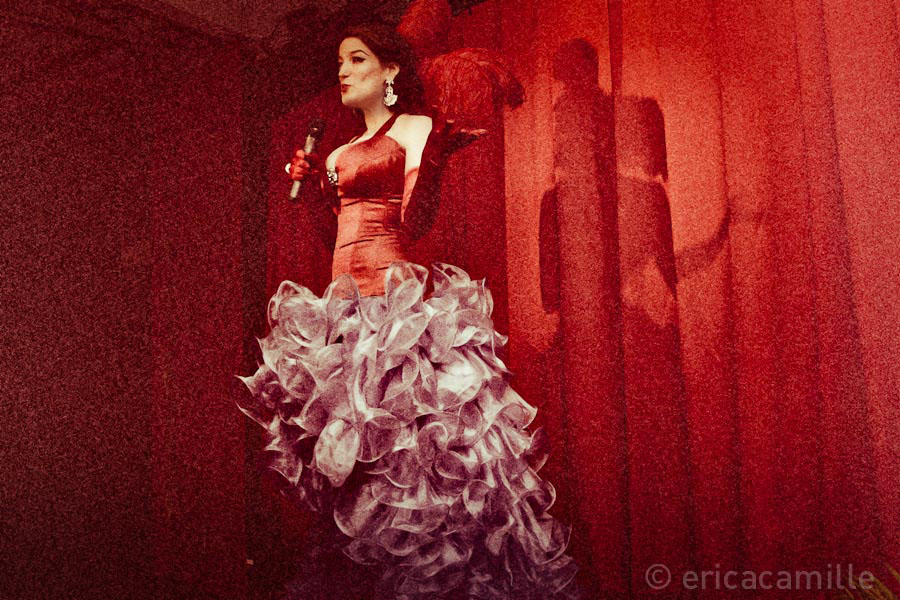
Juliette, photo by Erica Camille
So how did it all get started? Read on for my interview with Juliette, who’s responsible for the whole thing.
brooklyn spaces: So how did it all get started?
Juliette: I really had a vision. I just decided I wanted to do a nightclub like Paris in the 1920s. Paris and Berlin and Shanghai all had these very decadent underground club scenes at that time. There was so much turmoil throughout the world, but people who have traditionally been marginalized—artists, intellectuals, gay people, people of color—have historically created underground scenes as a reaction to the mainstream, which then, ironically, takes its cues from the underground. Anyway, at the very beginning, my dear friend Tanya Rynd suggested that i throw some parties in lieu of trying to start an actual nightclub, to see if anyone was interested. For the first party, I think we each sent out fifty emails, and we were really particular about who we invited, because we wanted people who would really get it and appreciate it. And it was amazing. I had friends who had this space in Dumbo, and even though Dumbo hasn’t been dangerous for a long time, at night it’s kind of desolate, and four years ago even more so. People would be walking around going, “Are we in the right place?” and they’d walk through this maze of tagged walls, and then they’d hear music, and they’d walk in and it was just complete glamour, candlelight and chandeliers, the whole thing. It was really unexpected, which for me is part of the magic. You want to feel like you’re in a different time and place. That’s really my goal, to make people feel like they’ve been completely transported.
brooklyn spaces: It’s kind of like a gift you’re giving to people.
Juliette: I don’t think there’s enough glamour in the world, I really don’t. Even though we may not have any money, we certainly can have glamour. If you have talented and creative people around you, you can make anything you want. But it’s definitely a lot of work, you have to be really obsessed to manifest your vision because it’s definitely against all odds, sometimes.
brooklyn spaces: So what happened to the Dumbo space?
Juliette: Well, we outgrew it really quickly. Shanghai Mermaid got listed on Nonsense NYC, which is a wonderful list, and Jeff Stark wrote something very nice about it—I think he mentioned that we use real glassware. It was really exciting, but it made the party huge. And the landlords happened to be driving by and they called the cops and the fire department. About a dozen fire trucks and cop cars descended on the space. They walked in and were like, “Oh my god.” But they stayed for like an hour. Amber Ray was performing when they finally turned the lights on and the music off, and everyone started booing. I said, “You know what? You’ll look way cooler if you let her finish her number.” And they said okay. They were really, really cool.
brooklyn spaces: Did you get the Red Lotus Room right after that?
Juliette: No. We were mobile for awhile, which was so much work. Everything at Shanghai—tables, chairs, tablecloths, bar, chandeliers, curtains, the stage, the lights, the sound—we had to bring all that with us. Then we’d set up for hours, and when it was over, I’d be sweeping the floor in a ball gown at seven in the morning. So I knew I needed my own space, I didn’t want to keep setting up and breaking down. But finding a space in Brooklyn is super hard. I looked for a year and a half. I really wanted Red Hook, I wanted something on the water, I love turn-of-the-century warehouses, but finally I realized I had to be realistic. I like that it’s in Crown Heights, that people have to go a little bit out of the way to get here. I think when you have to work harder for something, you appreciate it more. Like the dress code. I hate to turn people away, but if someone’s going to go spend money and time to create an outfit from another era, I don’t want other people to come in in a polo shirt and jeans. It’s not fair and it breaks the whole illusion.
brooklyn spaces: What’s your relationship with the people in the neighborhood?
Juliette: I try to be a part of the community, and I’ve had a great response. I support the neighborhood, I buy everything I can around here. And there’s all these little kids, really nice kids, and they don’t have anything to do, so sometimes I let them come in, and I show them the backstage area and all the costumes, and I let them on the stage. I really want to try to do kids’ workshops or classes here, it’s definitely something the community needs. On the whole, there’s good things and bad things about gentrification. I remember being at Home Depot when we were first building out the space, and this guy said, “I’m so happy white people have moved into this neighborhood.” I said, “You are?” and he said, “Yeah, because now when you call the cops, they come.” That just gave me the chills.
brooklyn spaces: Who are some of your favorite performers to work with?
Juliette: Les Chauds Lapins, they were the very first act at the very first Shanghai Mermaid. I love Hot Sardines, Baby Soda Jazz Band, Blue Vipers of Brooklyn—they were also at the first Shanghai Mermaid. For burlesque performers, I tend to go for people who are costumey and conceptual, like Veronica Varlow, and Maine Attraction, she’s got this great personality, very Josephine Baker. Amber Ray performed at the April in Paris party, when everything was very French and dramatic. Then there’s the fire performers, there’s so many great ones, like Reina Terror, Christine Geiger, Lady C and Flambeaux. And for aerialists I adore Seanna Sharpe, and of course Anya Sapozhnikova from House of Yes and Lady Circus; she’s another example of someone who’s not only a performer, as I am, but who works her ass off to run her own venue while performing all around town. I’m very impressed with her and her dedication.
brooklyn spaces: Do you think the exclusive nature of the parties attracts people?
Juliette: Shanghai Mermaid is not exclusive, and I’ve never wanted it to be. Everyone is welcome. It’s just that for survival it had to be really on the down-low. Although lately it’s not so down-low anymore; it’s listed as a venue on Time Out New York, Gothamist just wrote about it, the Village Voice called it the “Best Literally Underground Cabaret Show.”
brooklyn spaces: Since this is a Brooklyn blog, tell me your thoughts on being in Brooklyn these days.
Juliette: I very much believe in Brooklyn, in the Brooklyn scene. I think Brooklyn’s really exciting. There’s still a little bit of a Wild West quality here, which I don’t feel like Manhattan has anymore, it’s gone really corporate. The party-throwers in Manhattan, they have PR agents and big websites, they want to do a lot of corporate stuff. I usually stay away from that. There’s definitely money in it, but the thing is, who are you creating it for? Not that people who go to corporate events don’t deserve something fabulous, but it’s just not something I’m going to go after. I guess I’m a purist.
brooklyn spaces: What’s one of the best, most beautiful memories from the parties?
Juliette: I’ll always remember the very first moment at the very first Shanghai Mermaid when the curtains opened and Les Chauds Lapins were playing, and I looked around and saw all these people dressed so beautifully, and I thought, “We did it, and it’s so lovely!” It really was how I imagined it. That’s a great memory. Opening night at the Red Lotus Room was really exciting too. It’s a tremendous amount of work, but it is super rewarding to be able to do something like this and share it. And I’ve always been very, very blessed to have beautiful wonderful people come. When I walk down the aisle, people grab my arm and say, “Thank you so much for doing this.”
***
Like this? Read about more underground party spaces: Rubulad, Newsonic, Gemini & Scorpio loft, The Lab (Electric Warehouse), 12-turn-13, Gowanus Ballroom, Big Sky Works

